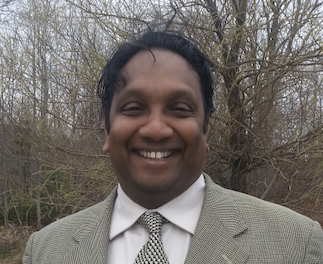 It sounds simple, but Shah Razul’s work involves trying to understand what water molecules do when they get to below zero degrees Celsius because the possibilities that understanding offers could be life-changing.
It sounds simple, but Shah Razul’s work involves trying to understand what water molecules do when they get to below zero degrees Celsius because the possibilities that understanding offers could be life-changing.
When water crystallizes, its volume increases and it forms a regular structure that destroys, for example, cells, or, in the case of an organism, its delicate membranes and systems. As most of us will know, when food is frozen and we leave it too long, the ice separates out, leaving the food “freezer burned.” A wasted chicken breast is one thing, but this problem also exists, for example, in cryopreservation of cells, tissues and organs.
“When water’s in a close-to-frozen state, it has some interesting behaviour,” says Razul, an associate professor of chemistry at St. Francis Xavier University. “We're trying to understand what the water molecules are doing.”
Razul’s overarching goal is to find a way to keep water from forming crystals and then applying that learning to real-world problems in areas such as food and health care.
“If we can, we can solve many problems related to freezing,” he says, including, for example, potentially creating environmentally safer antifreeze products to replace or minimize the use of road salt.
He looks to creatures such as the wood frog, which uses glucose to stop the freezing process from destroying its tissues in winter. Razul, therefore, is running simulations to look at the process of freezing and analyze what water molecules are doing in the fractions of a second just before they form crystals and freeze.
“A lot of my work now is involved with understanding how small biomolecules, such as different kinds of sugars and salts, stop water from freezing or slow down the process,” he says, adding that he wants to figure out a biomolecular combination that would achieve this goal.
Over the past five years, he’s been using computational principles to develop a cryoprotectant to preserve lobster meat.
“We’ve tried it and it works,” he says, adding that some companies from overseas are testing his system currently. “We had a taste test in Atlantic Canada, and we've published a couple of studies where the public indicated that it tastes as if it was cooked yesterday, preferring it to frozen lobster meat that is sold currently.”
His next frontier is looking at the ways in which his process can preserve muscle cells and brain cells to see what kind of applications it might have in the healthcare field.
“No one has a definitive answer to how these cryoprotectants work at the molecular level,” he says. “It's basically all trial and error. We try a little bit of this and a little bit of that and see whether it works.”
To do his work, he’s watching the behaviour of water in minute detail — fractions of seconds — and then he replicates the test multiple times.
“Because of that, I generate a lot of data,” he says, and that’s why he couldn’t do his work without ACENET’s high performance computing.
“It's almost impossible to do this work without ACENET,” he says. “I would need a year and a half to do it sequentially as opposed to one month with ACENET.”
Spring, 2023